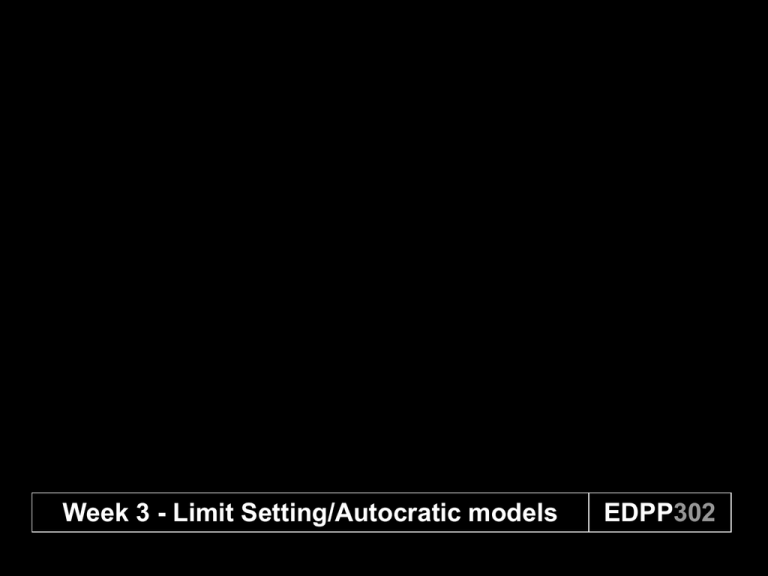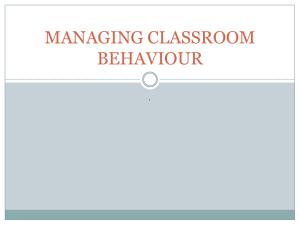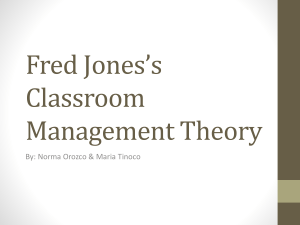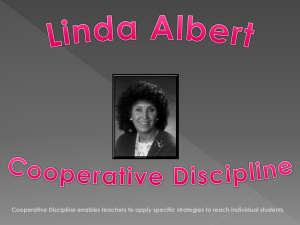PPT
advertisement

Week 3 - Limit Setting/Autocratic models EDPP302 2 teacher-centred, limit setting models of behaviour management more on setting limits Assertive Discipline in detail. How it is done. The Tension Model CONSEQUENCES an outcome of decisions Positioning Skill based subjective more indirect individual FEEDBACK modelling mirroring narrative reflection notices difference evocative DECISION MAKING TENSION disequilibrium dissonance Tension issue resolved continues advice giving lecturing interrogation transparent options judgemental prescriptive Limit Setting Models Assertive Discipline – Canter & Canter Preventive Discipline - Jacob Kounin Positive Classroom Discipline - Fred Jones Jacob Kounin Bill Rogers Decisive Discipline Group Management Fred Jones Neo-Adlerian Positive Discipline Balson/Dreikurs Humanism Ginott/Rogers Systems Theory Solution focussed Applied Behaviour Analysis Choice Theory Behaviour Modification William Glasser Canter & Canter Assertive Discipline Cognitive-behaviourism Models of Behaviour Management Continuum Autocratic Democratic Student Laissez-faire empowered Limit Setting Leadership Internal Non-directive motivation Characteristics of the Models Students require firm direction from teachers Learning and behaviour are closely linked Positive classroom relationships allow teachers to be trusted and respected Disruptive behaviour occurs in all classrooms. Good teachers use techniques to negate its impact on learning THE CRISIS CYCLE Integrated experience External control Staff actions Internal control Client actions Preventive Discipline - Jacob Kounin teaching and discipline need to be integrated interested, stimulated and active learners reduce the risk of disruptive behaviour planned and coordinated activities within lessons reduce the likelihood of disruptive behaviour a positive, productive classroom atmosphere or tone is pervasive for all participants Preventive Discipline - Jacob Kounin Ripple effect Withitness Overlapping Smoothness and momentum Group alerting when teachers correct misbehaviours in one student, it often influences the behaviour of nearby students the disposition of the teacher to quickly and accurately identify problem behaviour or potential problem behaviour, and to act on itdoing immediately. more than one thing at once. Regardless of the level of classroom activity, the teacher continues to be aware of student’s individual activities and moving in and out of activities expects them to be working.remain on smoothly, with appropriately paced task. and sequenced instruction keeping all students attentive in a whole-group focus Kounin, Jacob S. (1970) Discipline and Group Management in Classrooms. Holt, Rinehart and Winston, Inc. Positive Classroom Discipline - Fred Jones Classroom management procedures must . . . . be positive and gentle. set limits and build cooperation in the absence of coercion be economical, practical and simple ultimately reduce the teacher's work load. offer incentives and encouragement for positive effort Jones, Fred (2000) Tools for Teaching. Santa Cruz, CA: Frederick Jones and Associates. Positive Classroom Discipline - Fred Jones Three different management strategies are integrated to form a three-tier approach to discipline management. Limit-setting Incentive systems Back-up systems ‘limit-setting and relationship building form a tier of the management system which we might best describe as the interpersonal-interactive level of management.’ from http://www.fredjones.com/Positive_Discipline/Discipline_Ch18.html Positive Classroom Discipline - Fred Jones Three different management strategies are integrated to form a three-tier approach to discipline management. Limit-setting Incentive systems Back-up systems Something the teacher can provide that students like so much that in order to get it they will work throughout the period/week/month. Examples include PAT (preferred activity time) and positive reinforcement from http://www.fredjones.com/Positive_Discipline/Discipline_Ch18.html Positive Classroom Discipline - Fred Jones Three different management strategies are integrated to form a three-tier approach to discipline management. Limit-setting Incentive systems Back-up systems A series of responses the teacher can call upon after the above fails. A sequence of consequences administered within the classroom and a backup system outside the classroom from http://www.fredjones.com/Positive_Discipline/Discipline_Ch18.html Positive Classroom Discipline - Fred Jones Positive Classroom Discipline - Fred Jones There are seven steps in limit setting: Eyes in the back of your head Terminate Instruction Turn, look, and say the student’s name Walk to the edge of the student’s desk Prompt Palms Camping out Stop what you are doing and concentrate on the disruption Face the student, make eye contact, Walk calmlycalm to front and remain of student’s desk and Demonstrate what is avoid comments expected Lean towards the student Shift and maintain eye contact to show you are still aware 2 teacher-centred, limit setting models of behaviour management more on setting limits Assertive Discipline in detail. How it is done. Setting limits Redirecting the thoughts of students back to their behaviour and creating a dilemma for them in which a decision or action is needed Setting a limit is not the same as issuing an ultimatum. You can finish the work nowdon’t and finish go the work If you out to lunch with the others if it back is you willorstay at lunch. unfinished you will stay back at lunch and I can help you with it. You decide. Setting limits Redirecting the thoughts of students back to their behaviour and creating a dilemma for them in which a decision or action is needed Setting a limit is not the same as issuing an ultimatum. The purpose of limits is to teach, not to punish. Through limits, people begin to understand that their actions, positive or negative, result in predictable consequences. By giving such choices and consequences, a structure for good decision making is provided. Setting limits Redirecting the thoughts of students back to their behaviour and creating a dilemma for them in which a decision or action is needed Setting a limit is not the same as issuing an ultimatum. The purpose of limits is to teach, not to punish. Setting limits is more about listening than talking. By listening, you will learn more about what’s important to students, and that will help you set more meaningful limits. Setting limits Explain which behaviour is inappropriate 5 Saying ‘Stop that!” may not be enough. The person may not know if you are objecting to how loudly he is talking or objecting to the language that he is using. Be specific. Setting limits Explain which behaviour is inappropriate 5 Explain why the behaviour is inappropriate. Don’t assume the student knows why her behavior is not acceptable. Is she disturbing others? Being disrespectful? Not doing a task she’s been assigned? Setting limits Ultimatums often lead to power struggles because no one wants to be “forced” to so something. By providing choices with consequences, you are admitting that you cannot force his decision. But you can determine what the consequences for his choices will be. 5 Explain which behaviour is inappropriate Explain why the behaviour is inappropriate. Give reasonable choices with consequences. Setting limits Give a few moments for a decision to be made. If upset, the student may not be Explain which behaviour thinking clearly. It may take her longer to is inappropriate think through what you’ve said. 5 Explain why the behaviour is inappropriate. Allow time. Give reasonable choices with consequences. Setting limits It’s important to set consequences that are reasonable, enforceable, within your Explain which behaviour is inappropriate Be prepared to enforce your consequences. . . . authority, and within the policies and procedures of your facility or school. 5 Explain why the behaviour is inappropriate. Allow time. Give reasonable choices with consequences. Setting limits Explain which behaviour is inappropriate Be prepared to enforce your consequences. 5 Explain why the behaviour is inappropriate. Allow time. Give reasonable choices with consequences. Download ‘The Art of Setting Limits’ from CPI 2 teacher-centred, limit setting models of behaviour management more on setting limits Assertive Discipline in detail. How it is done. Assertive Discipline – Canter & Canter Teachers have the right to determine what is best for your students, and to expect compliance. No pupil should prevent you from teaching, or keep another student from learning. Student compliance is imperative in creating and maintaining an effective and efficient learning environment. To accomplish this goal, teachers must react assertively, as opposed to aggressively or non assertively. Hostile Teachers see students as adversaries use an abrasive, sarcastic and hostile style focus on the person not on the behaviour meet their own needs but disregard the needs of the students Non-assertive Teachers ignore or react in desperation use a passive, inconsistent, timid and non-directive manner do not communicate their needs to the students show an uncertainty and fear of the students Assertive Teachers respond confidently, politely and quickly give firm, clear, concise directions to students build positive, trusting relationships are demanding, yet warm in interaction listen carefully to what their students have to say, and treat everyone fairly (not necessarily equally). Assertive Discipline – Canter & Canter Clear set of observable, class negotiated rules. Only 3 - 5 max. For behaviour that breaks the rules a clear, pre-determined set of consequences are laid out. Focus on positive behaviour with constant reinforcement through comments and recording of compliance. All students are targeted for both positive recognition and negative consequences when relevant. CLASS RULES No talking when the teacher is talking Stay in your seats Keep your hands and feet off other people and their property Follow the instructions given by the teacher CONSEQUENCES 1st name on board 1st warning 2nd tick - 2nd warning 3rd tick - 3rd warning 4th tick - stay back after class 5th tick - lunch time detention 6th tick - leave the class, interview with head teacher/AP CLASS CONSEQUENCES CLASS RULES 1st incident name on board - 1st warning No talking when the nd teacher is talking 2nd incident tick - 2 warning Stay in your seats rd 3rd incident tick - 3 warning your hands off after otherclass 4th Keep incident tick -and stayfeet back people and their property 5th incident tick - lunch time detention Follow the instructions given by the 6th teacher incident tick - leave the class, interview with head teacher/AP CLASS RULES No talking when the teacher is talking Stay in your seats Keep your hands and feet off other people and their property Follow the instructions given by the teacher CONSEQUENCES 1st name on board 1st warning 2nd tick - 2nd warning 3rd tick - 3rd warning 4th tick - stay back after class 5th tick - lunch time detention 6th tick - leave the class, interview with head teacher/AP Is it worth it? Caleb Fabio Suzie Jack Bashir Shannon Carly Jess Ryan Hassan Tamika Lucas Common pitfalls with Assertive Discipline Students will not stop behaviours and often will be pushed to get more ticks as a challenge or act of revenge Ticks are delivered as punishment/consequences not cues/signals The list of students will be selective rather than inclusive Ticks are delivered only to certain students in the class No evidence of a ripple effect Positive comments to compliant students are not used enough or they are insincere Little dilemma for students to change Appropriate positive consequences are not in place Jonahs contract How would you handle Jonah? View video REFERENCES Canter, L. & Canter, M. (1976) Jones, Fred (2000) Assertive discipline – a take charge approach for today’s educator. Santa Monica, CA Tools for Teaching. Santa Cruz, CA: Frederick Jones and Associates. Kounin, Jacob S. (1970) Discipline and Group Management in Classrooms. Holt, Rinehart and Winston, Inc. CLASS RULES No talking when the teacher is talking Stay in your seats Keep your hands and feet off other people and their property Follow the instructions given by the teacher back CLASS CONSEQUENCES 1st incident name on board - 1st warning 2nd incident tick - 2nd warning 3rd incident 3rd warning tick - stay back after class 4th incident stay back class tick - lunch timeafter detention 5th incident lunch the timeclass, detention tick - leave interview with head teacher/AP tick - leave the class, interview with head teacher/AP 6th incident back







